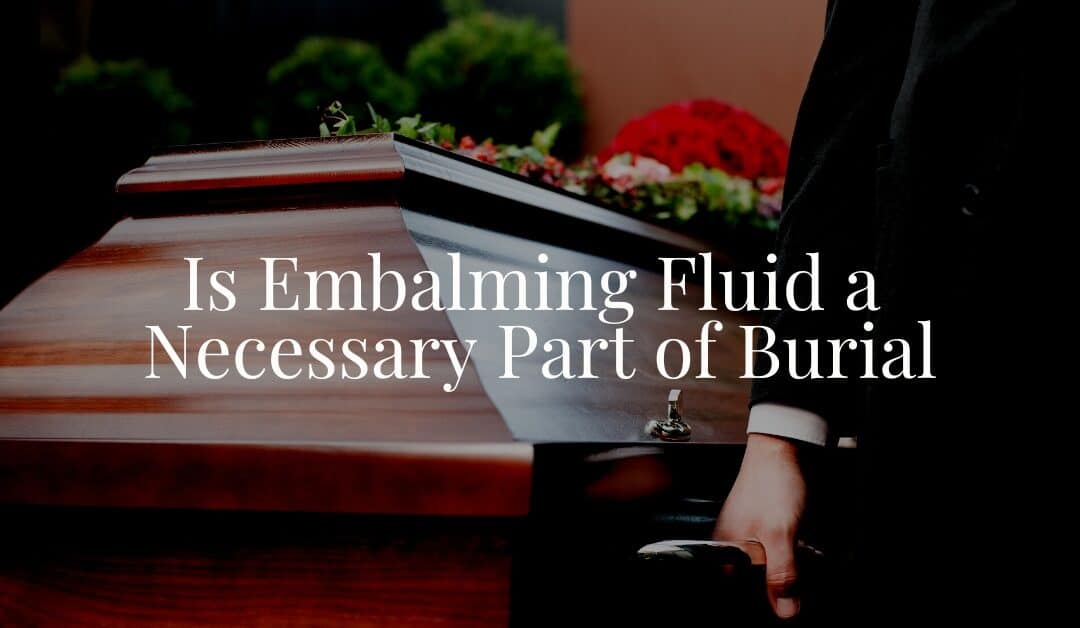When a loved one dies, most of us want to do whatever we can to ensure that they are given a proper burial. One step in this process is using embalming fluid, a compound that helps preserve the body. But what is an embalming fluid made from? Is it toxic? This article will explore the answers to these questions and more.
What Exactly Is Embalming Fluid?
Embalming fluid is a compound originally developed by Thomas Holmes during the Civil War era to preserve body tissue. Embalming became necessary to return deceased soldiers of the Civil War to their home and family. For the first time, thousands of men were dying far from home. Embalming allowed them to be returned to their families.
Embalming fluid is made from formaldehyde, methanol, ethanol (ethyl alcohol), and other solvents. Its wide usage spread in popularity across our country and the world as a fixative to keep tissue preserved.
Funeral directors often help families preserve and restore a natural appearance for viewing by family members. As humans, it is difficult watching our loved ones pass away. Embalming fluids can give us the time we need to say goodbye.
Funeral homes offer embalming services because it’s not always easy to plan visitations, wakes, or other services. When the family wants the deceased’s body present, plans for services often mean giving time for far-away loved ones to arrive.
Embalmers use a substance containing preservatives, disinfectants, sanitizers, and additives. Through this complex combination of chemicals, modern embalming helps postpone decomposition. Embalming fluid includes a combination of formaldehyde, glutaraldehyde, methanol, and other solvents.
Because these are strong chemicals, it makes sense to consider your reasons for choosing an embalming process as part of a body’s preparation.
Why Use Embalming Fluid?
When someone dies, your funeral home prepares their body for burial or cremation. Embalming fluid preserves bodies by stopping bacterial growth and decay. The preservative action of funeral embalming keeps tissue and organs in a preserving solution.
While it is not necessary to embalm a body to have a funeral service, some people do so for aesthetic preservation reasons.
Embalming fluid helps slow the decomposition of the body and restores a natural, peaceful appearance – even after death.
How Does the Embalming Process Work?
The embalmer injects a mixture of embalming fluids into the arterial system of the deceased’s abdomen and body cavity. They then remove blood, gas, and fluid from the body’s organs and cavities.
Embalmers then drain the arterial system and “inject the embalming fluid.” Another specialty fluid known as cavity fluid may also be injected. Cavity treatment helps preserve and hold off decomposition. (1)
Modern Embalming Fluids
The technology for embalming fluid has greatly advanced over the years. In fact, early versions of embalming fluids were highly dangerous due to their high concentration of methanol.
Due to improved quality control measures and safety protocols, modern embalming fluids may be safer and less toxic than their predecessors. However, many embalming fluids still contain formaldehyde content as high as 37%, while the methanol content may be up to 56%.
Some companies now also offer “green” embalming fluids certified by the Green Burial Association of America.
Embalming Fluid Ingredients
Some of the solutions used to preserve bodies for funeral purposes include these modern-day chemicals:
- Preservative (Arterial) Chemical. A mixture of formaldehyde, glutaraldehyde, or phenol. Methanol holds the formaldehyde in solution. Formalin refers specifically to 37% aqueous formaldehyde and is not commonly used in funeral embalming but rather in the preservation of anatomical specimens.
- Water Conditioner. Balances the “hardness” of water (the presence of other trace chemicals that change the water’s pH or neutrality) to reduce acidity, since formaldehyde works best in an alkaline environment. Water conditioners may also inactivate chemotherapy drugs and antibiotics, which can prevent the workings of the preservative chemicals.
- Cell Conditioner. Prepares cells for absorption of arterial fluid and breaks up clots in the blood vessels.
- Active dyes: Restore the body’s natural color and help prevent conditions such as jaundice from showing through. Also may give the venous system appropriate coloring.
- Inactive dyes: Give a pleasant color to the fluid in the bottle but do nothing for the appearance of the embalmed body.
- Humectants: Helps restore moisture to tissue for a more natural and hydrated appearance.
- Anti-Endemic Chemicals: Draws excessive fluid (edema) out of a body.
- Specialty Chemicals: Chemicals that kill tissue gas or bacteria.
- Water: Most arterial solutions are diluted with water. Waterless embalming is needed in difficult cases or those requiring a very high degree of preservation, such as when an extended delay between death and final disposition is needed.
- Cavity Fluid: A high-index formaldehyde or glutaraldehyde solution injected undiluted directly into the body cavities to treat the viscera. In cases of tissue gas, phenol-based products may be used instead. (2)
When a loved one dies, most of us want to do whatever we can to ensure that they are given a proper burial.
What Are The Risks?
The use of embalming fluid has been linked to health risks for funeral professionals who are exposed to it on a regular basis. Long-term exposure can damage internal organs such as the liver, kidneys, and lungs. In addition, many environmental groups believe preserving a body is unnecessary and harmful to the environment.
Formaldehyde, in large amounts, can be carcinogenic in humans and animals and cause unwarranted cell replication, leading to cancer. Formaldehyde released from the cremation of embalmed bodies enters the atmosphere and rains down onto plants, animals, and water supplies below. (3)
The United States uses roughly 5.3 million gallons of embalming fluid every year! (4)
Because of the environment, some individuals choose “green” burial without the use of embalming fluid. A natural decomposition process allows bodies to return to the soil without the use of solvents.
Choosing to NOT Use Embalming Fluids
Returning to the age-old practice of laying our loved ones to rest, green burial is a reverent and traditional way of internment. In fact, it remains the overarching form of funeral service within Judaica and Conservative Moslem sects today.
Choosing a green burial allows family members to bury their loved ones in an eco-friendly way. The body is wrapped in a simple shroud or casket, crafted from biodegradable materials, and will decompose naturally when buried. This approach allows for a truly natural transition back into the earth.
Natural burials are the perfect option for those wanting to minimize their ecological footprint after death. Death is a natural part of life, and through nature’s assistance, we can gracefully return our bodies back into the cycle of growth by utilizing plants and soil in our burial land.
Benefits of Green Burial Include:
- Green burials may cost less since no vaults or concrete boxes are needed.
- Biodegradable caskets and wrappings decompose naturally and quickly.
- Embalming not necessary
Because of the standards put forth by the Green Burial Council, cemeteries across North Carolina use their guidelines to create green cemeteries or sections.
If you would like to experience a green burial with biodegradable materials, consider these cemeteries as the ultimate location for your final resting place. These sites provide an opportunity to sustainably conserve nature while commemorating those who have passed away.
- All Souls Natural Burial Ground, Greensboro, NC
- Bluestem Cemetery, Cedar Grove, NC
- Historic Oakwood Cemetery, Raleigh, NC
- Pine Forest Memorial Gardens, Wake Forest, NC
- Carolina Memorial Sanctuary in Mills River, NC
By employing biodegradable burial materials, a conservation cemetery can develop a memorial ground that reduces carbon dioxide and allows traditional graves and cremated remains to coexist in one harmonious location.
Green burials are beneficial from an environmental standpoint and provide families with peace of mind, knowing their beloved’s resting place will remain untouched by modern developments.
We Can Help
Whether you’re planning for your own services or those of a loved one, it makes sense to consider the finer points of how it all will work. At Renaissance Funeral Home and Crematory in Raleigh, North Carolina, we can help answer any questions you may have about preparation for a funeral or memorial service.
We exist to help families create beautiful and memorable events for their loved ones. Grieving together can help families heal and have hope going forward. We would love to talk with you about what we offer and how we can help. Contact us today to get started with your plans!


